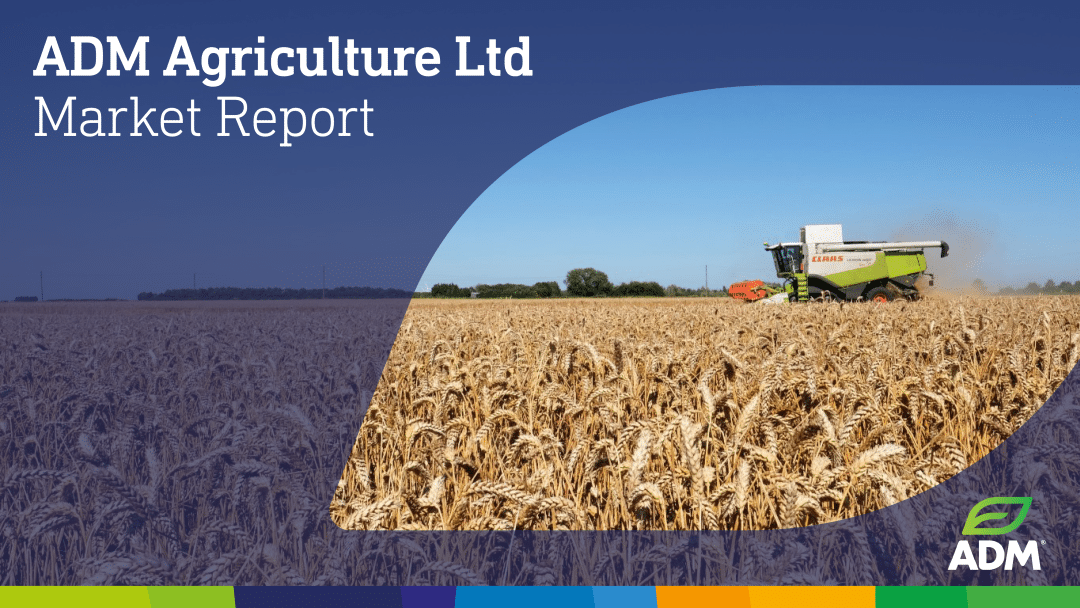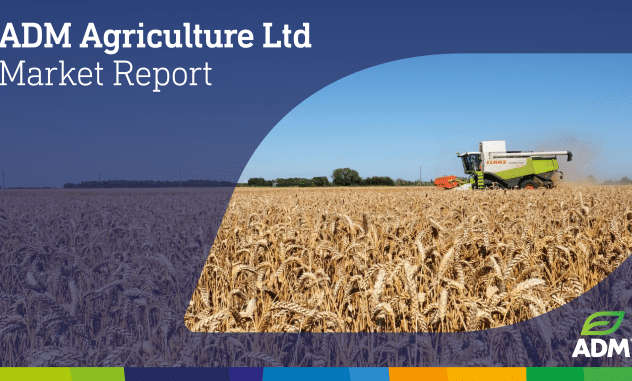WELCOME TO THE ADM AGRICULTURE WEEKLY MARKET REPORT
Wheat
- The US market has fallen $4.50/t w/w, despite a weak US$ with the market beginning to re-test recent lows.
- The US market remains routine, and exports continue at the pace to reach the projected volume, although traders remain concerned that the lower prices are not encouraging importers to secure additional US supplies.
- Winter wheat harvest is now virtually complete, and with spring wheat harvest progressing smoothly, the supply pressure should keep any short-term rallies in check.
- EU prices are down €7.50/t pressured by a relatively firm Euro/US$ exchange rate. Russian and Ukrainian wheat exports continue to advance, while EU exports continue their slow early pace for 2024/25, reported as being 3.55mln t a/o 18th August, down 22% y/y.
- Egyptian officials remain confident in securing their 3.8mlnt tender, although this is now expected to be via private talks with traders, and government-to-government deals, rather than open market tenders, in which Russia is expected to feature heavily. The Egyptian government estimates their stock levels to currently sit at 6 months’ worth and wants to increase this to a 9-month supply in the coming weeks.
- UK prices have also been on the defensive due to the pound’s recent rise against the US$, trading above $1.30 for the first time in over a year. Prices have declined £4.45/t ww/w, although producer selling remains slow.
- The lack of fresh suppliers being made available is allowing spot-delivered prices to firm in the more far-reaching north and west of the country, as traders and merchants try and persuade long holders to ‘part-company’ with the last of their old crop supplies, and smaller new crop bulks.
- In summary, the wheat market seems to be lacking any enthusiasm which is allowing prices to drift lower. US prices seem destined to test recent lows, European farmers remain strong-holders, and Black Sea supplies continue to look plentiful with export prices seemingly stabilising w/w.
- While this scenario remains, it is difficult to paint a bullish factor to the market, especially in the short-to-medium term. Long-term, US corn and beans crops have a ‘lot of weather’ to get through, and with global wheat supplies projected to fall y/y, market direction could soon depend on sowing and soil conditions for the Northern Hemisphere 2025 harvest season.
Barley
- Harvest progress has slowed on the week as temperatures cool and we have seen showers across the country have hampered proceedings. Spring barley is now 34% complete overall in the UK, with England just edging over the 50%-mark, spring barley in Scotland remains a few weeks away from being fit.
- Feed markets have a tight feel to them as farmers continue to focus on gathering in the remaining harvest rather than making sales, and liquidity is very poor as a result. Consumer activity is strong for another week as futures push lower, and feed barley remains competitive vs other feed products in domestic rations. As a result, the spread vs barley and wheat continues to slowly squeeze in.
- Feed barley export demand once again remains a non-event, and barley is looking unattractive in destination markets vs corn. We also see some aggressive offers coming out of the Baltic region which undermine UK replacement levels. In the long term, our lack of competitiveness poses an issue for the balance sheet as we have a sizeable surplus of barley to ship, particularly as the incoming spring barley crop is trending above average yield.
- Malting barley markets continue to feel pressure on lack of demand and the European/Scandinavian harvests progressing with good quality results coming in. UK barley is looking close to perfect, although Nitrogen content remains low at around 1.45% average – this is posing an issue for export markets where many buyers are trying to propose a minimum Nitrogen guarantee. However, as harvest progresses, we are seeing the average N level creep higher – something to watch. Overall, malting barley continues to feel heavy, other than the fact that it now looks remarkably ‘cheap,’ and farmers will no doubt feel unenthused to make sales with today’s premiums.
Rapeseed
- Ag markets have been mixed this week with soybeans finding support around $9.60 on the Nov contract as we have seen renewed interest from China. So far USDA has announced a new flash sale each day this week, this is positive, though it is worth remembering that we are still severely behind average so will need to see much more demand come forward to relieve concerns. The US Dollar had fallen this week to the lowest we have seen since last year which has helped bring some support and make exports look more attractive.
- This week we have had the Pro Farmer Tour making its way through US growing states to assess the condition of the Nation’s corn and soybean crops. So far soybean pod counts look good and have given us no reason to doubt the USDA’s historical production and yields.
- Energy markets have been sharply lower this week as concerns over Chinese demand follow a sharp decline in Chinese hope prices for July. Also, we have previously seen both EIA and OPEC lower their consumption expectations due to disappointing Chinese demand. Last week it was reported that China’s refiners processed 13.91 million barrels per day in July, the lowest since October 2022. We have also seen pressure in prices from reports that the Israeli Prime Minister has accepted a ‘bridging proposal’ to tackle disagreements that are preventing a ceasefire. API stocks were 347,000 barrels higher last week versus an expected 2.9-million-barrel decline.
- Malaysia has kept export duty on palm oil unchanged at 8% and has raised the base price for calculation. In Ukraine and Russia, further declines in sunseed production are expected due to critical-rated soil moisture conditions. The forecast does not look like we will see any relief this week.
- Canola has followed soybeans higher this week prompting some fund short covering after Friday’s COT report showed speculative shorts at 137,000 contracts, 20,000 more than the previous week and now representing 42% of the open interest. The Alberta Government adjusted expected canola yields lower last week to 34.20 bushels per acre from 34.60 previously and last year’s 37.90.
- MATIF rapeseed prices have been mixed as a sharply higher Euro/Dollar has capped any significant gains. Prices have been supported at €449, though have been unable to break the downward trend that has been in place since July. The canola matif spread has now come out to $88 and we have seen some canola trade into the EU. This means that any fall in canola prices will be met by a similar reaction in MATIF. Canola is currently the cheapest arrival into the EU before the Australian harvest starts in December.
Oats
- The ever-growing confidence in a bounce in Scandinavian oat production is causing the oat market to fall further from the highs set last year.
- Buying demand has been very poor with most millers looking to hold off from making fresh purchases until they capture the demand from their consumer customers.
- Demand for feed oats in the EU remains poor and this is not surprising given the availability of other cheaper feed grains. This is also compounded by the lack of interest from Spain which has seen a large recovery in their domestic production this year.
- Here in the UK harvest is progressing nicely with many growers reporting yields much better than first feared. The early planted crops have produced some fantastic quality with many seeing specific weights in excess of 54kg/hl. However, the late planted springs remain the key unknown and this is what will ultimately determine the direction of the UK market.
- Bottom line, oat prices have seen a significant fall from last year’s highs however with harvest about to begin in Scandinavia we will soon get a greater understanding of the European balance sheet.
Pulses
- Harvest continues to progress across much of the UK for Pulses. Peas approach their end in the north, while beans are stalling in the midlands, as late sown springs are still not ready. New crop markets continue to remain quiet for both peas and beans, however, there could be the potential of some Human Consumption markets building for export, albeit once there is a better handle on quality.
- Early Bean yields look promising, remaining in the 3.5-4mt/ha bracket. The week ahead looks to be taking a turn for the worse weather-wise, with cooler than normal temperatures in the North, and at least 15mm of rainfall across most of the UK, with some areas in the Northwest due as much as 40mm.
- Beans have maintained a relatively static relative value compared to their competing products on the week but still need to give c. £15-20/mt of value to compete against other proteins, such as DDG’s from the ethanol plants and Rapemeal from the domestic crushes. As harvest gathers pace again in the coming weeks, we will likely see further corrections lower as beans fight to be more relevant in winter diets.
- Looking at the currency markets, the short-term outlook for GBPEUR and GBPUSD is influenced by market uncertainty, with GBP facing pressure from a potential UK economic slowdown, inflation, and central bank decisions. GBPEUR remains steady amid Eurozone challenges, while GBPUSD fluctuates due to US economic resilience and Fed interest rate policies. Crudely, strong GBP = cheaper imports/weak GBP = more aggressive exports.
- It is worth talking to your Farm Trading representative about all things Pulse at the moment! With a combination of some great buybacks, various seed stocks ready to go, and a portfolio of cost-effective inputs, such as PGrow and FibroPhos, that can really help push your yield potential, they are all ready and happy to help. We have a wide spread of homes nationally, so can offer competitive origination markets, plus the opportunity to upgrade human consumption pulses to be processed in one of the most advanced pulse processing plants in the UK and Europe, the team is here to help.
- Finally, the ever-present PGRO plug to those eligible to be members. If you are not already signed up to the PGRO mailing list, you can sign up here where levy payers can access all sorts of advice and support, tapping into their extensive knowledge bank on all things pulses for free! The PGRO is a unique organisation within the UK, and if you are paying for it, you may as well use it!!
Seed
- As the bank holiday approaches and the weather appears to be showing rain many have re-focused on Oilseed Rape as conditions become favourable for drilling, ADM has a portfolio of the country’s leading rape seed varieties packed and ready to go or collection from local stores.
- Demands for the group 1 varieties have increased over the past week with several leading varieties starting to short and looking likely to go sold out very soon. We have limited supplies of the new introduction RGT Goldfinch, the BYDV-resistant group 2 variety which we are looking to place out on ADM Agri buyback contracts remember, if you do not use insecticide you could qualify for the £45 Ha.
- The feed wheats are starting to gather momentum and some varieties becoming difficult to find, if you are planning to grow specific varieties that suit your land type, please get your orders in to ensure you can secure the variety you are planning to grow.
- If you will be using a winter cover this year for grazing or soil health, speak to your ADM farm trader to find the mix best suited to you. We can also offer bespoke mixtures available upon request.
- Looking to sow a grass ley this autumn?
- Whether it is a long- or short-term mix, for grazing or silage, we have several options available.
Fertiliser
- While demand in Europe and South America for urea is tentative, prices are being maintained by Indian demand, continued limited Chinese exports, and Egyptian manufacturers that continue to run at 80% of full potential.
- The picture remains unchanged for phosphates which are facing sustained tight supply compounded by high seasonal demand in Europe and India.
- This further increases the competitiveness of UK-produced renewable PK fertilisers supplied by ADM agriculture versus DAP and TSP.
- Ammonium nitrate 33.5% saw a price increase in France this week. We could see a knock-on effect cross to this side of the channel.
- The USD has further weakened against GBP as the market prices in expected interest rate cuts by the FED in September, giving imports into the UK a more competitive edge.
| £/€ | £/$ | €/$ |
|---|---|---|
| 1.1775 | 1.3110 | 1.1135 |
| Feed Barley £ | Wheat £ | Beans £ | Oilseed Rape £ | |
|---|---|---|---|---|
| Nov24 | 147-162 | 177-192 | 220-230 | 380-385 |
NB: Prices quoted are indicative only at the time of going to press and subject to location and quality.
“Although ADM Agriculture take steps to ensure the validity of all information contained within the ADM Agriculture Market Report, it makes no warranty as to the accuracy or completeness of such information. ADM Agriculture will have no liability or responsibility for the information or any action or failure to act based upon such information.”
ADM Agriculture cannot accept liability arising from errors or omissions in this publication.
ADM Agriculture trade under AIC contracts which incorporate the arbitration clause.
Terms and Conditions of Purchase.
On every occasion, without exception, grain and pulses will be bought by incorporating by reference the terms & conditions of the AIC No.1 Grain and Peas or Beans contract applicable on the date of the transaction. Also, we will always, and without exception, buy oilseed rape and linseed by incorporating by reference the terms & conditions of the respective terms of the FOSFA 26A and the FOSFA 9A contracts applicable on the date of the transaction. It is a condition of all such transactions that the seller is deemed to know, accept and understand the terms and conditions of each of the above contracts.



